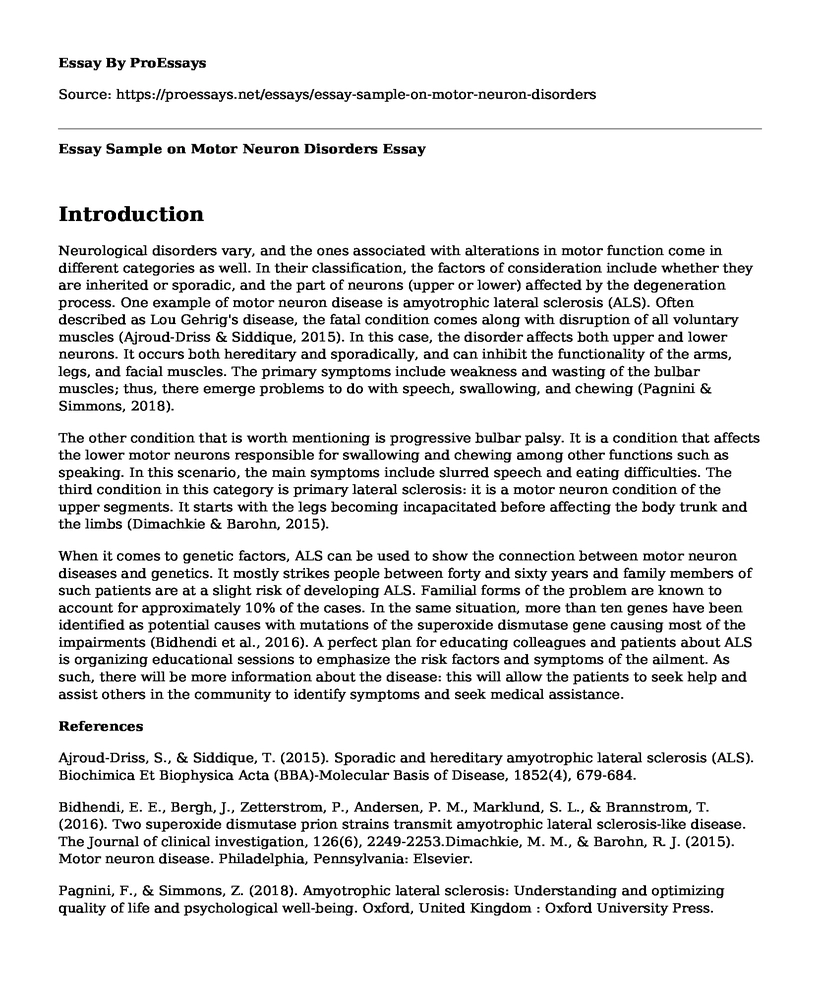Introduction
Neurological disorders vary, and the ones associated with alterations in motor function come in different categories as well. In their classification, the factors of consideration include whether they are inherited or sporadic, and the part of neurons (upper or lower) affected by the degeneration process. One example of motor neuron disease is amyotrophic lateral sclerosis (ALS). Often described as Lou Gehrig's disease, the fatal condition comes along with disruption of all voluntary muscles (Ajroud-Driss & Siddique, 2015). In this case, the disorder affects both upper and lower neurons. It occurs both hereditary and sporadically, and can inhibit the functionality of the arms, legs, and facial muscles. The primary symptoms include weakness and wasting of the bulbar muscles; thus, there emerge problems to do with speech, swallowing, and chewing (Pagnini & Simmons, 2018).
The other condition that is worth mentioning is progressive bulbar palsy. It is a condition that affects the lower motor neurons responsible for swallowing and chewing among other functions such as speaking. In this scenario, the main symptoms include slurred speech and eating difficulties. The third condition in this category is primary lateral sclerosis: it is a motor neuron condition of the upper segments. It starts with the legs becoming incapacitated before affecting the body trunk and the limbs (Dimachkie & Barohn, 2015).
When it comes to genetic factors, ALS can be used to show the connection between motor neuron diseases and genetics. It mostly strikes people between forty and sixty years and family members of such patients are at a slight risk of developing ALS. Familial forms of the problem are known to account for approximately 10% of the cases. In the same situation, more than ten genes have been identified as potential causes with mutations of the superoxide dismutase gene causing most of the impairments (Bidhendi et al., 2016). A perfect plan for educating colleagues and patients about ALS is organizing educational sessions to emphasize the risk factors and symptoms of the ailment. As such, there will be more information about the disease: this will allow the patients to seek help and assist others in the community to identify symptoms and seek medical assistance.
References
Ajroud-Driss, S., & Siddique, T. (2015). Sporadic and hereditary amyotrophic lateral sclerosis (ALS). Biochimica Et Biophysica Acta (BBA)-Molecular Basis of Disease, 1852(4), 679-684.
Bidhendi, E. E., Bergh, J., Zetterstrom, P., Andersen, P. M., Marklund, S. L., & Brannstrom, T. (2016). Two superoxide dismutase prion strains transmit amyotrophic lateral sclerosis-like disease. The Journal of clinical investigation, 126(6), 2249-2253.Dimachkie, M. M., & Barohn, R. J. (2015). Motor neuron disease. Philadelphia, Pennsylvania: Elsevier.
Pagnini, F., & Simmons, Z. (2018). Amyotrophic lateral sclerosis: Understanding and optimizing quality of life and psychological well-being. Oxford, United Kingdom : Oxford University Press.
Cite this page
Essay Sample on Motor Neuron Disorders. (2022, Oct 25). Retrieved from https://proessays.net/essays/essay-sample-on-motor-neuron-disorders
If you are the original author of this essay and no longer wish to have it published on the ProEssays website, please click below to request its removal:
- Description of the Chronic Disease that Happens in Older Age
- Postgraduate Dentistry Personal Statement
- Ethical Issues in Physician-Assisted Suicide Essay
- Essay Example on Rural & Remote Nursing: Bridging the Gap in Healthcare
- Brain Tumors: Cancerous, Noncancerous, Malignant, Benign - Essay Sample
- Nursing Philosophical View: A Holistic Perspective on the 4 Meta Paradigms - Essay Sample
- Report Sample on Management Concept in Health Care







